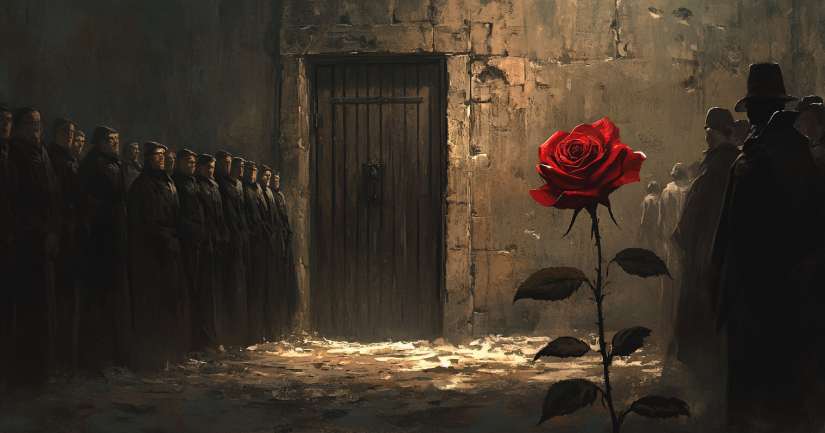
Explore the solemn opening of Hawthorne’s tale with Scarlet Letter Chapter 1 Quiz, where sin and judgment take center stage. This quiz invites you to explore the depths of Puritan society as you uncover the layers of symbolism and themes in this classic novel. Imagine the dreary prison door, weathered by time, standing as a testament to sin and judgment. The grim setting reflects the harshness of the community, a place where stones whisper secrets of transgression.
As you progress, you’ll gain insights into Hawthorne’s masterful use of imagery. The wild rosebush, a symbol of beauty amidst gloom, offers a glimmer of hope and resilience. By engaging with this quiz, you will delve into the complex interplay of light and dark that defines the novel’s opening. Each question will challenge you to think critically about the text and its deeper meanings.
Now that you’ve explored the opening chapter, why stop here? See how Hester’s journey unfolds in the Scarlet Letter Chapter 2, where public shame takes center stage. Want to test your knowledge of the novel as a whole? Take the ultimate challenge with the Scarlet Letter Full Book Quiz. And if you’re ready for the novel’s dramatic conclusion, check out the Scarlet Letter Chapter 24 for the final twists in Hester’s fate.
Prepare to unravel the intricacies of Hawthorne’s language. Discover how he sets the stage for Hester Prynne’s tale of defiance and redemption. Join us on this journey through The Scarlet Letter and enhance your understanding of its enduring legacy. Scarlet Letter Quizzes: From sin to redemption, explore every theme & chapter.
What Happened – Scarlet Letter Chapter 1
The story begins in front of a prison in a small town. The prison is old and made of wood. It is located in a colony in New England. The prison door is heavy and made of iron. The building looks dark and gloomy. The grass around the prison is overgrown. Weeds grow in the cracks of the stone path. The prison is next to a cemetery. Both the prison and cemetery are important to the town.
A crowd of townspeople stands outside. They are dressed in plain, dark clothes. They look serious and stern. Among the weeds, there is a wild rosebush. It grows next to the prison door. The rosebush is in full bloom. Its flowers are bright and colorful. The narrator describes the rosebush as a symbol of hope. The narrator suggests that the rosebush may offer comfort.
The chapter does not reveal much about the people. It focuses on the setting. The prison represents punishment. The rosebush represents beauty and kindness. The scene sets the tone for the story. It shows the contrast between harshness and gentleness. The chapter ends with a description of the rosebush. It leaves the reader with an image of the roses. The roses might offer a glimpse of something good in a harsh world.
Scarlet Letter Chapter 1 – Quotes
- “The founders of a new colony, whatever Utopia of human virtue and happiness they might originally project, have invariably recognized it among their earliest practical necessities to allot a portion of the virgin soil as a cemetery, and another portion as the site of a prison.” – {Narrator}, ‘This sets the tone for the novel, highlighting the themes of sin and punishment in the Puritan society.’
“A crowd of eager and curious schoolboys, understanding little of the matter in hand, except that it gave them a half-holiday, ran before her progress, turning their heads continually to stare into her face.” – {Narrator}, ‘The townspeople gather to witness Hester Prynne’s public shaming, illustrating the community’s judgmental nature.’
“In that early severity of the Puritan character, an inference of this kind could not so indubitably be drawn.” – {Narrator}, ‘This comment on the Puritanical mindset underscores the harshness and rigidity of the society Hester is living in.’
“The grass-plot before the jail, in Prison Lane, on a certain summer morning, not less than the two hundred years ago, was occupied by a pretty large number of the inhabitants of Boston.” – {Narrator}, ‘Introduces the setting and the townspeople gathered to witness Hester’s punishment.’
“Finding it so directly on the threshold of our narrative, which is now about to issue from that inauspicious portal, we could hardly do otherwise than pluck one of its flowers, and present it to the reader.” – {Narrator}, ‘The narrator introduces the story by inviting readers to engage with the tale of sin and redemption.’
Scarlet Letter Chapter 1 – FAQ
Chapter 1 of The Scarlet Letter is set in 17th-century Boston, Massachusetts. The scene opens with a description of a gloomy prison door, establishing a somber and oppressive atmosphere that reflects the strict Puritan society.
Hawthorne describes the prison as a dark, weather-stained building, symbolizing punishment and sin. The heavy, oak door is reinforced with iron spikes, emphasizing the harshness of Puritan law. Its presence in the town signifies the community’s focus on justice and morality.
The wild rosebush growing beside the prison door serves as a symbol of hope and resilience amidst the bleak environment. Hawthorne suggests that it offers a glimmer of beauty and compassion, contrasting the severity of the Puritanical setting. It represents nature’s ability to endure and flourish despite adversity.
Hawthorne uses the prison and the rosebush as powerful symbols to set the tone. The prison represents the rigid and unforgiving societal norms, while the rosebush symbolizes the possibility of grace and redemption. This contrast establishes the thematic tension between sin and forgiveness that permeates the novel.
Hawthorne starts with the prison to immediately introduce themes of judgment, punishment, and societal control. It highlights the community’s preoccupation with sin and establishes a backdrop for the personal and moral struggles that the characters will face throughout the story. By doing so, Hawthorne sets the stage for exploring the complex interplay between individual conscience and communal expectations.
